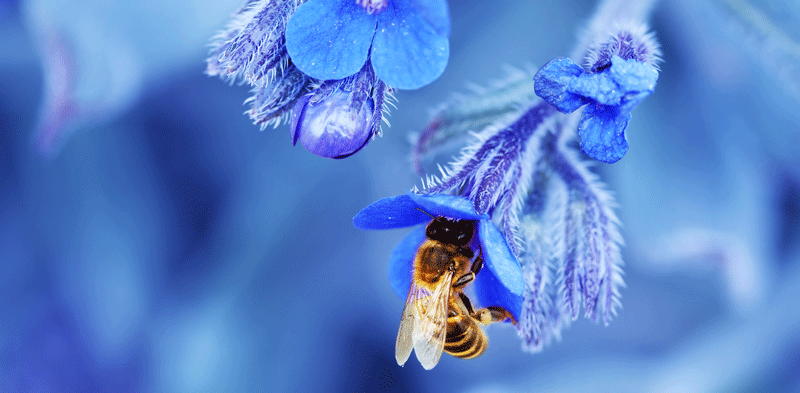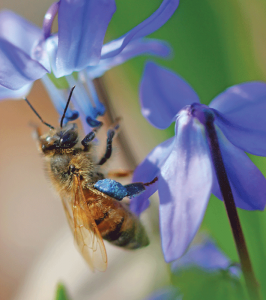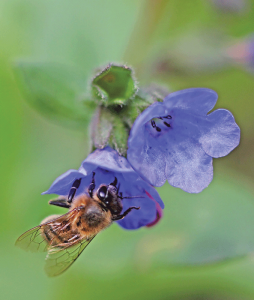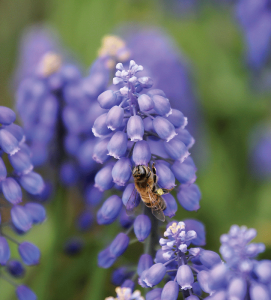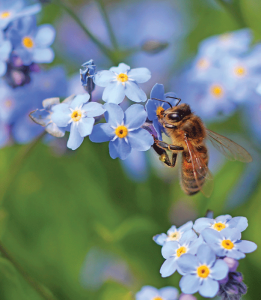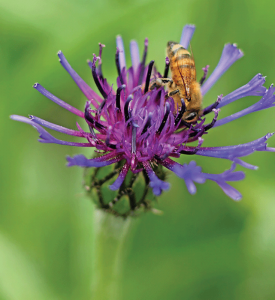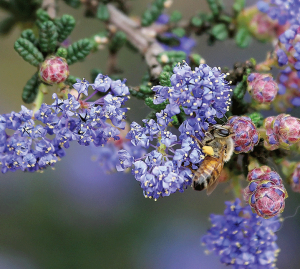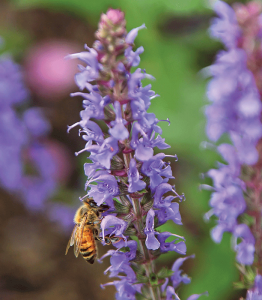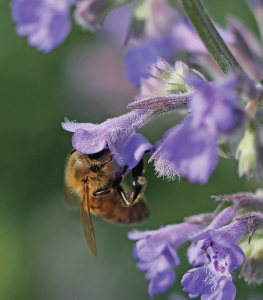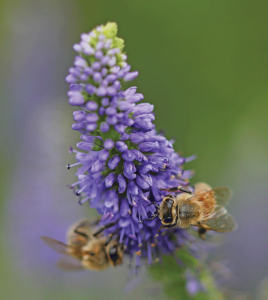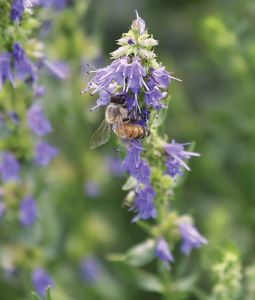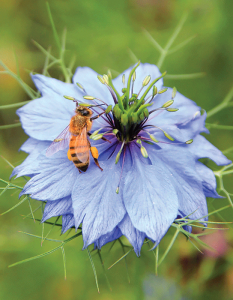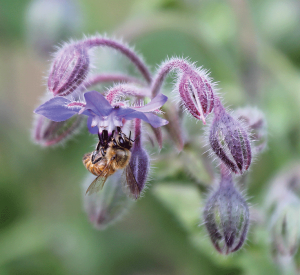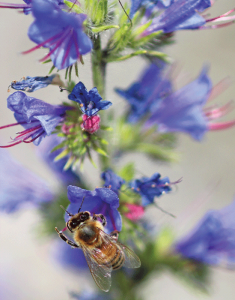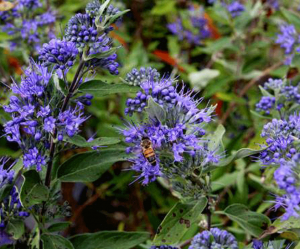By: Janet Davis
There’s something about shimmering blue flowers that fascinates gardeners – in fact some love them so much that they devote a special section in their garden to blue flowers only.
While that might be a little somber for you and me (blue flowers, after all, tend to recede in our vision compared to bright yellows and reds), a blue-flowered garden can be a supermarket for honey bees, provided the right plants are grown in quantity and in sequence throughout the foraging season, so there’s always something in bloom. Quantity is important, of course, because honey bees practise economy-of-scale in their foraging trips; they need a sufficient population of each preferred nectar- or pollen-rich plant to make a visit worthwhile. Unlike bumble bees and other native bees, honey bees are ‘flower-faithful’ or ‘flower-constant’, as Charles Darwin wrote, learning the intricacies of the anthers or nectaries, then working on one type of flower until its pollen or nectar is depleted. So if you have a small garden, choose just a few from the list below, but plant lots of them. And, of course, avoid the use of insecticides and herbicides.
Blue Flowers – Fascinating to Gardeners and Good for Bees.
Here are 17 excellent blue-flowered honey bee plants arranged sequentially from Spring to Fall.
Spring:
1. Siberian squill – Scilla siberica (Hardy Bulb)
This little bulb is so hardy and aggressive, it tends to naturalize over the years into large carpets of azure-blue in early Spring, even in lawns where the foliage can be left to ripen to nurture the bulbs for next year before being mown. That habit and its abundant bright-blue pollen on flowers just a few inches tall makes it a buzzing place on a sunny, warm day in April or May, not just with honey bees but with lots of natives, especially plasterer bees. Plant scilla bulbs in Autumn, when you would normally plant tulips and daffodils, in a sunny location at a depth two to three times as deep as the height of the bulb itself. (USDA Zone 2-8)
2. Lungwort – Pulmonaria sp. (Perennial)
A tough, hardy group of beautiful perennials for early Spring, the funnel-shaped blossoms of the various lungworts are a good source of nectar for bees. Lungwort prefers a lightly-shaded site with reasonably moist, humus-rich soil and grows to approximately 12 inches high and 18-24 inches wide. When conditions are favorable, lungworts will self-seed and even cross with each other, making large colonies. Good blue-flowered selections are ‘Blue Ensign’, ‘Trevi Fountain’ and ‘Munstead Blue’. (USDA Zone 4-8)
3. Grape hyacinth – Muscari armeniacum (Hardy Bulb)
Being grape-scented, rather than being a true hyacinth, is what gives this little Spring bulb its common name. Its nodding, white-edged, cobalt-blue flowers clustered on stems about six to eight inches tall are an excellent early source of nectar and white pollen for honey bees. Grape hyacinths flower at the same time as forget-me-nots, below, and they pair well together. Plant the small bulbs in Autumn at about twice the depth of the bulb’s height. And don’t worry if you see leaves emerging in Autumn; that is a perfectly normal trait of Spring-flowering muscari. (USDA Zone 4-8)
4. Forget-me-not – Myosotis sylvatica (Biennial)
This species is biennial, meaning it makes leaves the first year, then flowers, sets seed and dies in the second season. So abundant is the seed that, once planted, you’ll never forget it – thus its common name. It is a good source of nectar over a long period in Spring, and exhibits an interesting reproduction strategy. Once the tiny flowers have been pollinated, the fleshy five-part yellow ring at the center, which acts as a nectar guide, loses its yellow carotene pigment and turns off-white, signalling to the bees that nectar is no longer being produced. (USDA Zone 3-9)
5. Mountain bluet, perennial cornflower – Centaurea montana (Perennial)
All centaurea species – the knapweeds, cornflowers (including annual blue cornflower, C. cyanus), and weedy star thistles – are good sources of nectar and pollen for honey bees, but old-fashioned mountain bluet is a lovely addition to the late Spring-early Summer perennial garden. Bushy plants bear shaggy blue blossoms on two-foot stems, and repeat-flowering can be encouraged by deadheading spent blooms. Mountain bluet spreads by rhizomes and self-seeds readily and is considered invasive in some regions. (USDA Zone 3-9)
6. California lilac – Ceanothus sp. (Shrub)
Where they’re hardy, the dazzling, blue flowers of California lilac shrubs are bee magnets in Spring. The hardiest species and hybrids, including ‘Dark Star’, pictured, ‘Skylark, ‘Wheeler Canyon’ and ‘Henri Desfosse’ should survive Winter provided temperatures do not go lower than 15°F (-9°C). Grow California lilac in rich, well-drained soil in full sun, choosing a protected, south-facing spot in cooler regions. (USDA Zone 7-10)
Early-Mid Summer:
7. Meadow sage – Salvia nemorosa and Salvia x sylvestris (Perennial)
Most of the sages (Salvia species) are good bee plants, but meadow sage and its hybrids come in lovely blues and deep-purples that look beautiful with iris, peony, lupine, catmint and other early-Summer perennials. Meadow sage prefers well-drained, average soil in full sun. Excellent blue varieties include ‘Blue Hill’ (‘Blauhagel’), pictured, ‘May Night’ (‘Mainacht’) and ‘Caradonna’, all reaching 18-24 inches. (USDA Zone 4-8)
8. Catmint – Nepeta sp. (Perennial)
Long-blooming and an excellent source of nectar for honey bees and bumble bees, catmint is easily-grown in well-drained, average soil in full sun. Its aromatic foliage makes it highly deer-resistant. Catmint is often used in herb gardens, along with other bee-friendly herbs like oregano, thyme and holy basil. If cut back after their early Summer flowering, it will usually re-bloom in late Summer. Excellent choices are Nepeta racemosa ‘Walker’s Low’ and ‘Blue Wonder’, pictured, both about 18-24 inches tall and 18 inches wide. (USDA Zone 4-8)
9. Veronica – Veronica sp. (Perennial)
Many veronica species or speedwells are good sources of nectar and pollen, and popular with honey bees and bumble bees. Two of the best are early Summer’s Veronica spicata (one to two feet) and the taller, slightly later-flowering Veronica longifolia (three feet). With their lovely, blue flower spikes, both are well-behaved additions to the perennial border, long-lived, hardy and easy to grow in full sun and average soil. (USDA Zone 4-8)
10. Hyssop – Hyssopus officinalis (Subshrub)
Grown as a medicinal herb since antiquity, hyssop is native to eastern Europe and central Asia but is recorded as having arrived in North America in 1631 with the first colonists. It provides excellent forage for honey bees and bumble bees, and produces a fragrant, rich honey. In Bulgaria, one hectare of hyssop grown as a nectar crop can produce 150-175 pounds of honey. Drought-tolerant, it likes full sun and flowers from mid to late Summer. In milder climates, hyssop is evergreen; in cold regions, it dies back in Winter. Depending on the variety, hyssop grows between one to two feet tall, and should be sheared back after flowering to maintain a tidy shape. (Note that this is different from a plant often called anise hyssop, Agastache foeniculum.) (USDA Zone 3-10)
11. Love-in-a-mist – Nigella damascena (Annual)
Every garden can use a few annuals, and love-in-a-mist is one that is easily grown from seed broadcast in a sunny spot in average soil in early Spring, as soon as the ground can be worked. Love-in-a-mist adds charm to mixed plantings, where it is considered a ‘filler’ plant. The ‘mist’ part comes from the thread-like leaves that surround the flower, whose pollen-rich anthers attract honey bees and complex nectaries provide nectar. Plants grow 12-18 inches tall and the seed pods are lovely in dried arrangements.
12. Borage – Borago officinalis (Annual)
Bees adore borage, a mainstay of European herb gardens since medieval monks grew it in their apothecary plots. It is fun to watch honey bees hovering near one of the down-facing, blue (or pink) flowers before clinging to it briefly to gather nectar or pollen. Borage is grown as a commercial crop in North America for the omega-6 fatty acid GLA (gamma-linolenic acid) contained in the oil of its seeds, and hives brought in by local beekeepers have been shown to increase pollination of the flowers. Borage has been grown as a monofloral honey crop, including in Italy, where ‘miele di borragine’ is a delectable honey. Borage is easily grown from seed in constantly-moist average soil in sun or light shade, and will readily self-seed. It’s perfect for a vegetable or herb garden or waste places, but a little coarse for a flower border.
13. Viper’s bugloss, Blueweed – Echium vulgare (Biennial or short-lived Prennial)
Imagine a plant that grows wild in the gravel alongside our highways or in dry fields as being the source of a flavorful, light-amber, slightly lemony, monofloral honey. That would be viper’s bugloss or blueweed, native to Europe and temperate Asia, but a common weed throughout much of North America, where its azure-blue flowers are manna for honey bees and bumble bees. Viper’s bugloss reaches two to three feet in height and flowers from late June to August. (USDA Zone 3-8)
14. Chicory – Cichorium intybus (Perennial)
Another widespread roadside weed that attracts honey bees and all kinds of native bees with its sky-blue flowers is chicory. Native to Europe but naturalized throughout the world, chicory has long been grown as an edible, with the ground-up, roasted roots of one form used as a coffee substitute, and the somewhat bitter Spring leaves of other forms harvested for culinary use. It’s also grown as a forage crop in certain regions. But for bees, the value in chicory is in the sky-blue flowers loaded with abundant white pollen. While it’s not recommended that you plant chicory (it’s on the noxious weed list of a number of states), if it’s growing wild near your hives, it will prove to be a good source of Summer pollen. Grows to four to five feet and prefers dry, infertile soil. (USDA Zone 3-9)
Mid Summer-Autumn:
15. Globe thistle – Echinops sp. (Perennial)
Bumble bees and honey bees can often be found sharing the spherical, mid-late Summer flowers of globe thistle. Among the most commonly available species are Echinops ritro (the dwarf variety ‘Veitch’s Variety’ is shown here) and E. bannaticus. Although globe thistle is not thought of as a large-scale honey crop, its potential for honey production has been well researched in Poland. Depending on the species, globe thistle will reach three to six feet in well-drained, adequately moist soil in full sun. It makes a good garden partner to Russian sage, below. (USDA Zone 3-9)
16. Blue anise or hummingbird sage – Salvia guaranitica (Tender Perennial, Subshrub)
Though blue anise sage, native to South America, is traditionally known for the hummingbirds it attracts to its trumpet-shaped flowers, it is also a popular bee plant – even if honey bees must acquire the plant’s abundant nectar through nectar robbery, probing the corolla tube through holes made by the stronger proboscises of bumble bees or carpenter bees. The cultivar ‘Black and Blue’ is particularly beautiful, commonly available, and a good tropical plant for the late Summer garden. Plant it out in rich soil in a sunny spot when the soil is warm and all danger of frost is past and watch it reach four feet by mid-Summer. (USDA Zone 8-10)
17. Russian sage – Perovskia atriplicifolia (Subshrub)
This large, shrubby plant with aromatic grey-blue foliage from the steppes of Afghanistan (not Russia) bears wands of small, lavender-blue flowers for a long period from mid-Summer into Autumn. Honey bees and bumble bees are regular visitors for nectar. Though listed as a perennial (it was the 1995 Perennial Plant Association plant of the year), it is technically a subshrub, having woody stems that die back in varying degreeseach Winter. That’s important because it should not be cut back at the end of the gardening season, as with other perennials, but left unpruned until Spring when temperatures have moderated and new growth is showing. Russian sage grows best in full sun and average, well-drained soil, reaching a height of three feet and a width of four to five feet. (USDA Zone 3-9)
18. Blue mist bush – Caryopteris x clandonensis (Subshrub)
One of the last shrubs to bloom in the garden, usually in September-October along with asters and goldenrod, blue mist bush (aka blue spirea or bluebeard) literally buzzes with honey bees and bumble bees at a time when nectar flow is subsiding. Native to east Asia, the species itself is beautiful but there are a few exceptional cultivars, including ‘Dark Knight’ with deeper blue flowers and ‘Summer Sorbet’ with gold-variegated leaves. Although the roots are hardy to Zone 5, top growth of caryopteris is hardy only to Zone 7, therefore plants in Zones 5-6 should be mulched well in Winter. Winter-killed branches can be cut back to the ground in Spring to encourage vigorous new growth from the base. (USDA Zone 5-9)
References:
Introduction: Charles Darwin – Darwin, The Effects of Cross and Self-Fertilization in the Vegetable Kingdom. (1876)
4. Color change – forget-me-not nectar guide: www.researchgate.net/profile/Elzbieta_Weryszko-Chmielewska/publication/239045626_Morphology_and_anatomy_of_floral_nectary_and_corolla_outgrowths_of_Myosotis_sylvatica_Hoffm_Boraginaceae/links/568ff37708aecd716aedcabf.pdf
6. Hardiest ceanothus: horttech.ashspublications.org/content/19/2/411.full
10. Hyssop honey – pg. 214: www.agrojournal.org/13/02-08-07.pdf
12. Borage crop (Saskatchewan): www.usask.ca/soilsncrops/conference-proceedings/previous_years/Files/97/1997docs/364.pdf
Italian borage honey: www.apicolturacazzola.it/index.php?
option=com_virtuemart&view=productdetails&virtuemart_product_id=5&virtuemart_category_id=8&Itemid=504&lang=it-IT
13. Blueweed honey: https://honeybeesuite.com/vipers-bugloss-a-top-tier-honey-bee-plant/
14. Echinops ritro potential as Polish honey crop: http://www.jas.org.pl/pdf/73.pdf




